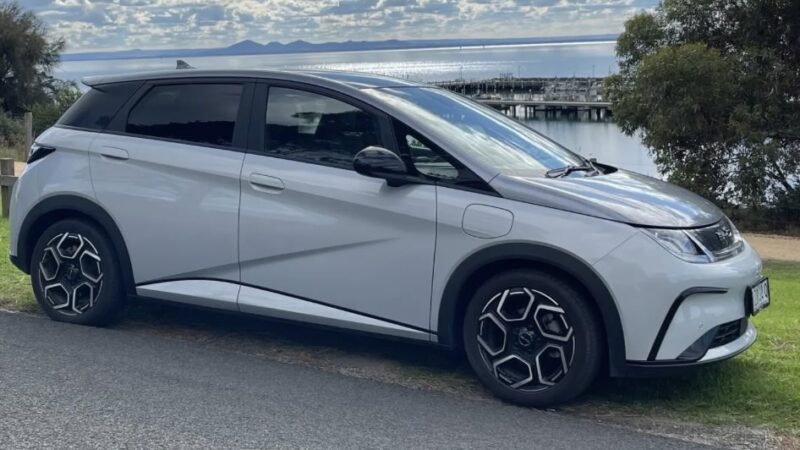The BYD Dolphin may have only hit the Australian market in October last year, but it still managed over 925 sales to the end of that year – many being pre-orders for what on paper looked to be one of Australia’s cheapest and, for the price, best specified battery electric vehicles (BEVs) to date.
Since then, to the end of May this year another 1,044 units have hit the road and it appears the Dolphin is going to be an ongoing sales performer for BYD, who hope to sell around 25,000 vehicles this year across a rapidly expanding stable of vehicle offerings.
The small passenger BEV is a growing segment: without considering price, it includes the MG4, GWM Ora, Renault Megane, Cupra Born and Nissan Leaf. However, when you throw an ‘under $50,000’ price criterion into the equation, the competition slims down to four: MG’s MG4 and lower range ZS EV, the GWM Ora and, more recently, the Nissan Leaf.
With Dolphin owners being very positive about the Dolphin driving experience – I decided it was time I should test one out.
The BYD Dolphin may be marketed as a budget EV but it sports many of the features found in pricier EVs. Also, whilst it isn’t a sharp handling ‘driver’s car’, it hits the mark for the average punter swapping to their first BEV. It offers excellent day to day transport that will get there safely and without hassle, whilst working well and efficiently as a full BEV.
For the price – personally I would shell out the extra $6,000 and pick the Premium for the extra range, performance and better rear suspension. On the other hand, $6,000 is a lot if you only do local to outer suburban driving. In that case – buy the Dynamic and pocket the difference: the cheaper Dynamic does not lose out in the ‘goodies’ department!
And for those wanting a more sporty version, they may not have long to wait. A ‘hot hatch’ Sport version of the Dolphin is expected to arrive in Australia sometime later this year.
Basic facts:
The BYD Dolphin was the second BEV offering brought to Australia from Chinese manufacturer, BYD. Built on the same dedicated electric car platform as the Atto 3 SUV and Seal passenger sedan, the Dolphin is marketed as a small passenger hatchback with seating for 5 and is officially classified as a “small passenger car.”
Whilst BYD vehicles can only be purchased online, BYD do offer ‘experience centres’ for viewing and arranging test-drives. Servicing and warranty work is done through BYD service centres as well as the independent mycar network.
The Dolphin comes in two variants, with the main differences shown in table 1:

Otherwise, the two versions are identical in specification except for the exterior/interior colour schemes.
Exterior
The version test driven here was a Premium riding on 17 inch wheels. The easiest way to tell the two versions apart from the outside is via the colour scheme. Premium versions come in two tone paint with a grey or black roof whilst the Dynamic comes in the same colour all over.
Whilst ‘beauty is in the eye of the beholder’, I found it attractive from all angles with its stubby bonnet, lightly rounded rear hatch and angular side body lines. By the way, the overall look of the Dolphin leads you to think it is smaller than its 4.29 metre length.
Under the bonnet
This where the major differences between the two versions start to show up. Whilst both are driven by a permanent magnet synchronous motor, the Dynamic produces 70 kW/180 Nm output, meaning its zero to 100 km/hr time is a ‘relaxed’ 12 seconds.
This changes up a notch or two with the Dynamic. There, the output is 150 kW/310 Nm giving a zero to 100 time of 7.0 seconds. The Premium also has multi-link rear suspension versus a torsion beam in the Dynamic.
Battery, range and charging
This is another area of difference between the two. The Dynamic has a 44.9 kWh battery, WLTP range of around 340 km and DC charging at 60 kW maximum. The Premium has a bigger battery and longer driving range (60.5 kW/427 km WLTP) as well as a higher maximum DC charge rate (80 kW).
As a result, the Premium has much the same zero to 80% DC charging time as the Dynamic. (When using an 80 kW or higher DC charger). AC charging is the same for both: up to 7kW single phase. (On three phase, will use one phase only).

In regards to the driving range – the Dolphin is able to give ‘dynamic’ estimates. (Dynamic estimates are based on the previous period of driving and adapt to recent driving history).
As I had been driving around town for the first 8 days, I started off on a country run from Melbourne to Fish Creek (near Wilsons Promontory in Victoria’s east) with a surprisingly high estimated range of 520 km.
As most of the trip was 100 km/hr freeway travel – by halfway it reflected the actual trip length with a revised estimate that would bring it in at around 380 km. Given it was a cold day and we had the heater on for the whole trip – that is about what you would expect for a BEV with 427 km WLTP.
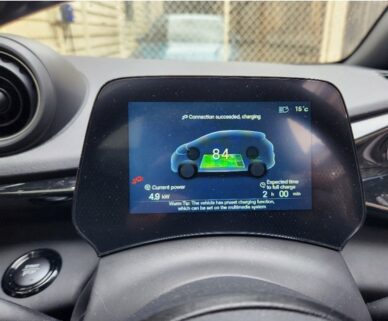
Vehicle to load
The BYD Dolphin can deliver approximately 2200W of 230V AC power via an adaptor plugged into the AC charge port.
Important note: This is a Vehicle to Load (V2L) system only. In order to avoid damage to the car or a 240V electrical system, owners must not attempt to use a V2L system to provide power directly into a home or off-grid electrical system. (An extended article on this topic is coming soon).
Interior
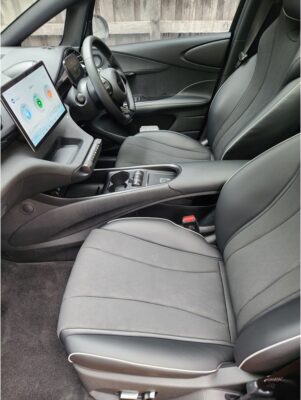
Unlike the Atto 3 with its slightly polarising interior styling (‘interestingly different’ to some, ‘garish’ to others) – the Dolphin has a more mainstream design and colour scheme.
All versions come with muted two-tone interiors matched to the exterior colour choice. Also, whilst the rising window line through the rear doors does make the rear feel slightly enclosed – it isn’t especially so.
Rear leg room is also surprisingly good – however for those over 1.8 metres tall, roof clearance might feel constrained due to the storage needs of the panoramic roof’s retractable sunshade.
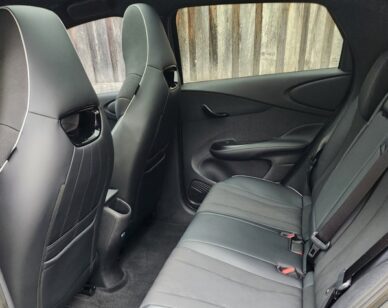
The panoramic roof is a nice touch. It creates an open, airy feel and, with its electrically retracted sunshade, adds a more upmarket feel than the Dolphin’s price would suggest.
The front seating is also surprisingly comfortable for a budget car. Shaped similarly to sports seats, they provide good support and locate the driver well. Adding another premium touch is the inclusion of electric adjustment for both front seats – 6-way for the driver and 4-way for the passenger. Seat heating is also included for both the driver and front passenger.
The rear seats are flatter, though not uncomfortable and can be folded 60/40. The boot floor can also be lifted to create a flat surface with folded seats (providing a hidey-hole underneath for leads or the like) or lowered to give more luggage height under the parcel shelf.
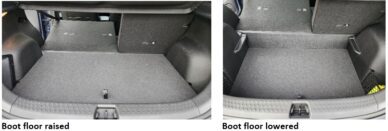
The dash layout is both simple, and practical. There is a small, but very practical 12.7 cm (5 inch) driver’s display showing the main information (speed, surrounding vehicle proximity, warnings etcetera).
The main game is played out on the central 32.5 cm (12.8 inch) infotainment touchscreen that (like all BYDs in Australia so far) can rotate between landscape and portrait. In terms of functionality, the touchscreen reacts quickly and most of the menus are easily found – although some menu choices feel counter-intuitive.
Examples include splitting the digital and FM radios menus as separate apps as well as the driving function and ADAS system selections being hard to find. (This latter by the way is not unique to the Dolphin).
Additionally, there are a number of physical buttons for operating many of the major functions. Drive mode, i-Pedal, fan speed and radio volume are placed in a handy row.
In that collection, and placed conveniently next to the driver, is the gear selector with the park button on the end. Altogether they made the driving experience that much easier (and safer) through reducing the need to fumble between menus on a touchscreen to adjust them. Steering wheel adjustments are the usual collection of radio, cruise control and driver’s display screen choices.
Centre console storage is good with a lidded bin in front of the cup holders, plus the usual USB A, C and 12V outlets in front and USB A/C outlets in the rear. Standard too is wireless phone charging.
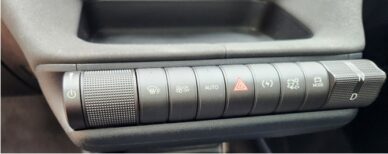
Sound is provided through a 6 speaker system and, whilst it can’t be compared to the Bose or Arkamys systems in higher priced EVs, is definitely more than adequate. Both Android Auto and Apply CarPlay are supported – mind-you there is little need to use Google Maps as the inbuilt navigation system is fully functioned.
Bluetooth was easy to connect to my Android phone and the speaker and microphone both performed well for easy conversation. For those with Apple phones: whilst Apple carplay is supported, it is done only through a hardwired USB connection.
Driving
In Premium guise, the Dolphin accelerates off the line smartly in both Normal and Sport modes. Acceleration is slightly more relaxed in Eco mode, but to be frank – there wasn’t a lot of difference to be found between all three.
Same for the ‘steering assist’ function – there was little to choose from between Sport and Comfort with Sport merely feeling slightly heavier. The owner’s manual suggests the Sport setting be used on the highway if the steering feels too ‘light’.
Ride and handling were what I would describe as being in the ‘Goldilocks’ zone – neither too hard not too soft, it gave a comfortable ride over all surfaces. With camera views from all four sides, parking and placing the vehicle was also a breeze.
Road noise at highway speeds was slightly louder than in some BEVs, but it was not intrusive and may in fact have been a function of the budget tyre choice made by BYD.
On that front – it was also possible to spin the wheels occasionally – although the ABS system did a good job in damping when it happened. It would be interesting to see what difference a higher spec EV tyre would make to the noise and grip of the Dolphin.
Safety
The BYD Dolphin received a 5 star ANCAP rating in October 2023. It comes with dual front and side airbags and a central airbag in the front, along with side curtain airbags for both front and rear. It also comes with a full suite of Advanced Driver Assistance System (ADAS) features.
These include autonomous emergency braking (car-to-car, vulnerable road user, junction & crossing, backover and head-on), lane support system with lane keep assist (LKA), lane departure warning (LDW), emergency lane keeping (ELK), speed assist system (SAS) and a speed sign recognition system. Also standard are child presence detection (CPD), driver fatigue monitoring (DFM), blind spot detection (BSD).
Pricing, Service and Warranty
On the road pricing in Victoria for the two Dolphin variants is $41,500 for the Dynamic and $47,500 for the Premium.
(These are Victorian price without incentives. Check incentives available in your state/territory. For instance up to $6000 and stamp duty savings are available in Queensland, which could lower the on-the-road price of a Dolphin Dynamic there to around $35,000).
Servicing is based on 12 month/20,000 km intervals. Pricing for the first 8 years/160,000 km is as follows:
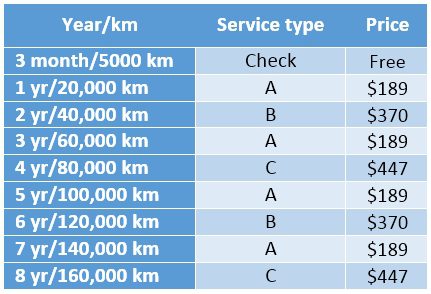
BYD provide the following warranty for the Dolphin:
- Complete vehicle: 6 years or 150,000 km, whichever comes first.
- Traction Battery: minimum 70% SOH remaining after 8 years or 160,000km, whichever comes first.
- Drive Unit: 8 years or 150,000km, whichever comes first.
Competitors:
The small passenger BEV is a growing segment: without considering price, it includes the MG4, GWM Ora, Renault Megane, Cupra Born and Nissan Leaf. However, when you throw an ‘under $50k’ price criterion into the equation, the competition slims down to four: MG’s MG4 and lower range ZS EV, the GWM Ora and, more recently, the Nissan Leaf.
Summing up
Marketed as a budget BEV, the BYD Dolphin sports many of the features found in pricier EVs. Also, whilst it isn’t a sharp handling ‘driver’s car’, it hits the mark for the average punter swapping to their first BEV. It offers excellent day to day transport that will get there safely and without hassle whilst working well and efficiently as a full BEV.
For the price – personally I would shell out the extra $6k and pick the Premium for the extra range, performance and better rear suspension. On the other hand, $6k is a lot if you only do local to outer suburban driving. In that case – buy the Dynamic and pocket the difference: the cheaper Dynamic does not lose out in the ‘goodies’ department!
As a final note: for those wanting a more sporty version, they may not have long to wait. A ‘hot hatch’ Sport version of the Dolphin is expected to arrive in Australia sometime later this year.
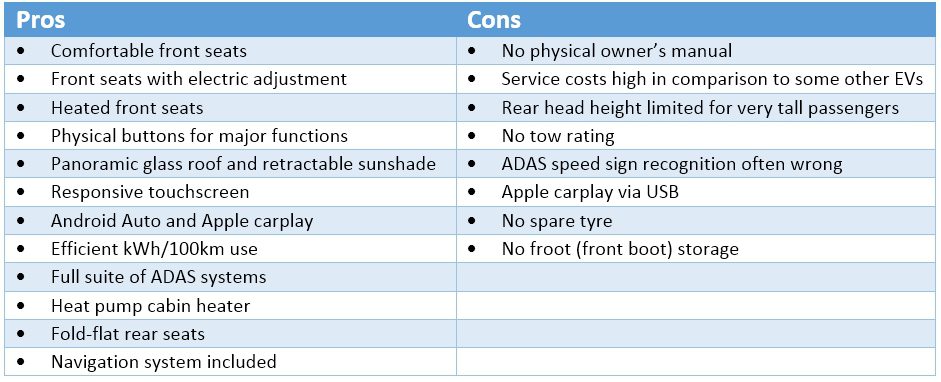
Specifications:
Seating: 5
Boot volumes in litres (1 litre = 10 x 10 x 10 cm)
- Boot under parcel shelf: 345
- Rear seat folded, loading space to roof: 1,310
Dimensions:
- Overall length: 4,290 mm
- Overall height: 1,570 mm
- Ground clearance: 130 mm
- Overall width (edge of doors): 1,770 mm
- Overall width (edge of mirrors): 2,012 mm
Battery:
- Dynamic: 46 kWh (44.9 kWh usable)
- Premium: 62 kWh (60.5 usable)
Energy consumption: (WLTP)
- 15.2 kWh/100 km (45 kWh battery)
- 15.9 kWh/100 km (60.5 kWh battery)
Kerb weight:
- 1,520 kg (45 kWh)
- 1,658 (60.5 kWh)
Charging:
- 1 phase AC: 7 kW max.
- 3 phase AC: 7 kW max. (Single phase only)
- DC: 60/80 kW max (45 kWh/60.5 kWh).
Charge port location:
- Right-hand front guard.
Drive configuration:
- Front-wheel drive
Towing:
- Not rated for towing
Performance:


Bryce Gaton is an expert on electric vehicles and contributor for The Driven and Renew Economy. He has been working in the EV sector since 2008 and is currently working as EV electrical safety trainer/supervisor for the University of Melbourne. He also provides support for the EV Transition to business, government and the public through his EV Transition consultancy EVchoice.

